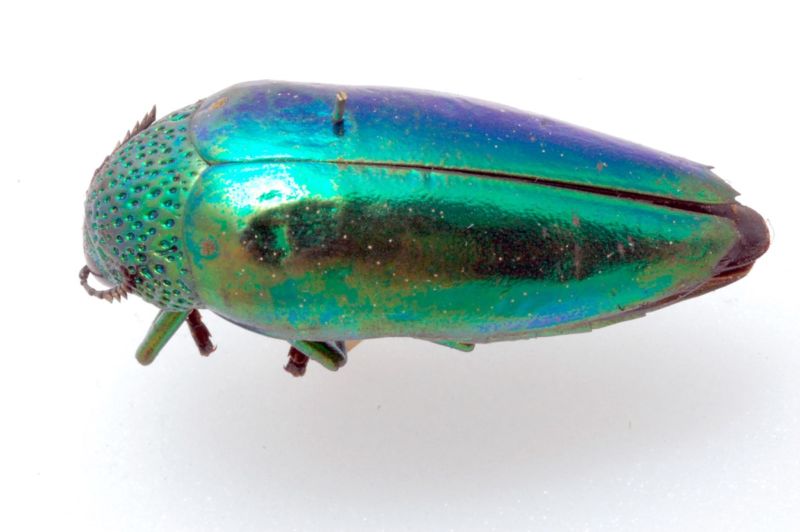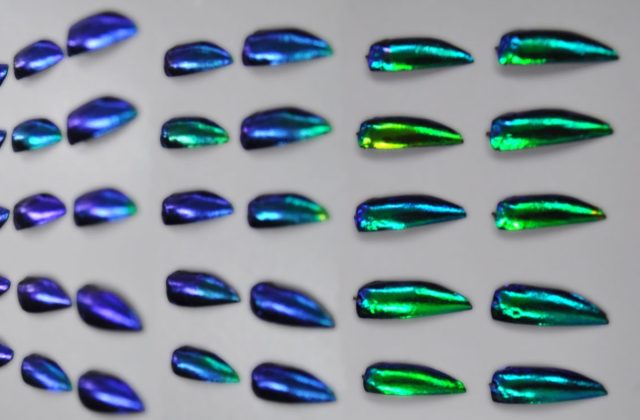
Artist and naturalist Abbott Handerson Thayer became known as the "father of camouflage" with the publication in 1909 of a book on coloration in animals. He was particularly fascinated by the phenomenon of iridescence: many species exhibit bright, metallic jewel tones that shift hues depending on viewing angle. While iridescence is often viewed as a means of sexual selection—think the magnificent peacock, shimmering his feathers to attract a willing peahen—Thayer suggested that in some species, it was also an effective means of camouflage.
Thayer endured a fair bit of mockery for his ideas, most notably from Theodore Roosevelt, a big game hunter who thought Thayer had grossly overstated his case. Indeed, there has been very little empirical support for Thayer's hypothesis in the ensuing century. But researchers from the University of Bristol have now uncovered the first solid evidence for this in the jewel beetle, according to a new paper in Current Biology.
What makes iridescence in nature so unusual is the fact that the color we see doesn't come from actual pigment molecules, but from the precise lattice-like structure of the wings (or abalone shells, or peacock feathers, or opals, for that matter). That structure forces each light wave passing through to interfere with itself, so it can propagate only in certain directions and at certain frequencies. In essence, the structure acts like naturally occurring diffraction gratings. Physicists call these structures photonic crystals, an example of so-called "photonic band gap materials," meaning they block out certain frequencies of light and let through others.

It has only been in the last few years that the first bits of evidence for iridescence as camouflage have emerged. In 2015, Thomas Pike of the University of Exeter reported that iridescence seemed to interfere with birds' ability to capture simulated virtual prey. And in a 2018 paper, Karin Kjernsmo, an evolutionary and behavior ecologist at the University of Bristol, and several colleagues showed that it also made it more difficult for bumblebees to identify a target shape. They concluded "that iridescence produces visual signals that can confuse potential predators, and this might explain the high frequency of iridescence in many animal taxa."
But there was still the question of whether biological iridescence really did confer a survival advantage for insects against common predators and what the underlying mechanism might be: camouflage or a means of warning potential predators that said prey is dangerous or unappetizing in some way (aposematism). So Kjernsmo is back with another study offering even more evidence that Thayer's hypothesis is valid. "The idea of 'iridescence as camouflage' is over 100 years old, but our study is the first to show that these early ignored or rejected ideas that 'changeable or metallic colors are among the strongest factors in animals' concealment' have traction," said Kjernsmo.
For this study, Kjernsmo et al. took to the field. They conducted experiments—using real jewel beetle wing cases as iridescence targets—in Leigh Woods National Nature Reserve in North Somerset, to observe if, and how, their bright colors helped them elude predatory birds.
"Although an iridescent insect might be easy to spot in a well-lit museum case, these spectacular colors may not shine as brightly in the dappled light of a natural environment, and so an iridescent beetle on a shiny leaf could be much more difficult to detect," said Kjernsmo. "If iridescence is to work as a form of protective coloration, it needs to work against birds, because birds are likely to be the most important predators of many iridescent insects."

The researchers attached mealworms to the wing cases (some brightly colored, some dull colors like black) and placed them on various plants in the woods. Then they kept track of how frequently birds attacked each group of targets. They also tested how well human beings could detect the targets in that natural setting. "I think that the biggest surprise to us was that when we carried out the same experiment with humans even they really struggled to spot the iridescent beetles," said Kjernsmo. "Both birds and humans really do have difficulty spotting iridescent objects in a natural, complex, forest environment."
Kjernsmo et al. also found that placing the iridescent wing cases against a glossy leaf background made it even more difficult to detect them, since this added considerable visual noise. Kjernsmo concluded that the jewel beetles' iridescence confuses predators by creating an illusion of inconsistent features and depth in the landscape—a kind of "dynamic disruptive camouflage," or, as Thayer put it, they appear "dissolved into many depths and distances."
"We don't for a minute imagine that the effect is something unique to jewel beetles; indeed, we'd be disappointed if it was," said Kjernsmo. "If we found that these beetles could be concealed by their colors, it increases the chances that many iridescent species could be using their colors this way." She will next be applying machine learning to different environments in hopes of learning more about how this type of camouflage might evolve in the wild.
DOI: Current Biology, 2020. 10.1016/j.cub.2019.12.013 (About DOIs).
Bagikan Berita Ini














0 Response to "Jewel beetle’s bright colored shell serves as camouflage from predators - Ars Technica"
Post a Comment